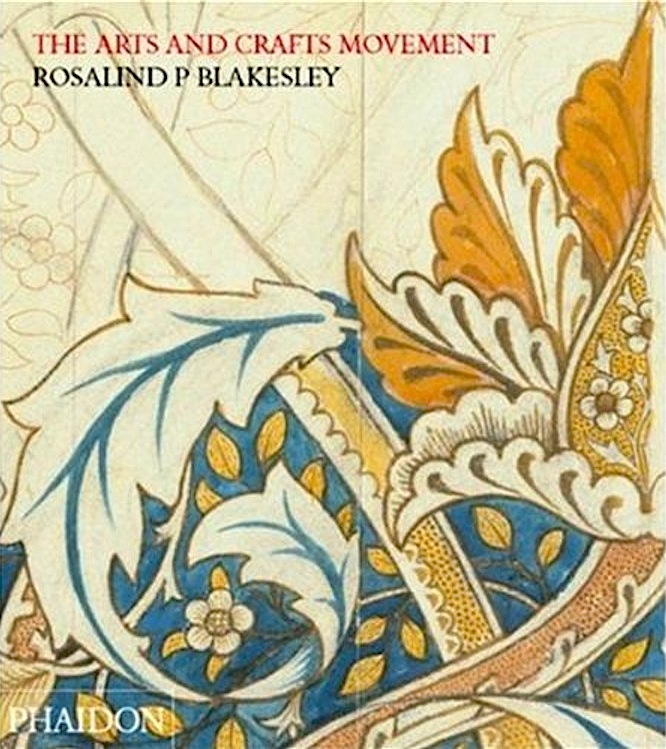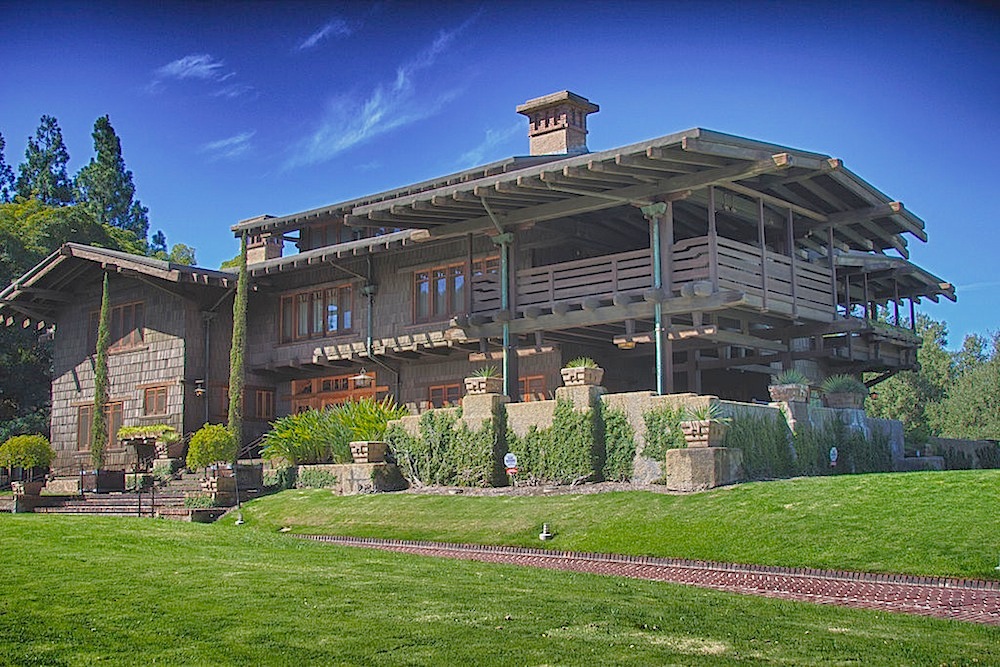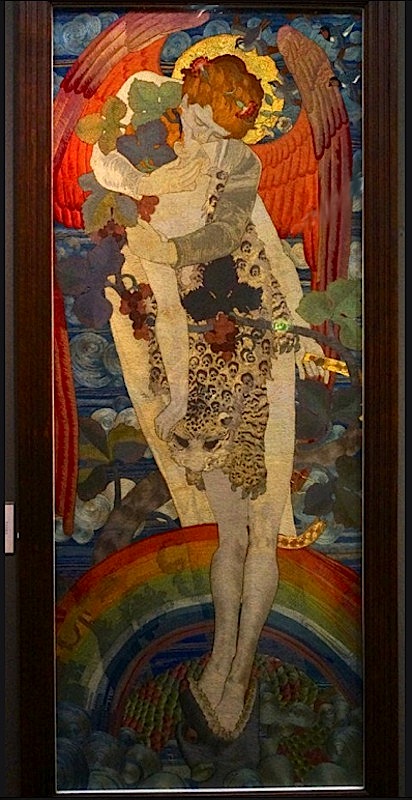This review is reproduced here by kind permission of the Historians of British Art, who first published it in a 2007 Newsletter. The original text has been reformatted and illustrated for the Victorian Web by Jacqueline Banerjee, who has also added captions and links, and updated publication details for some of the books mentioned. Click on the images for larger pictures and more information where available.

Cover of the first book under review.
The literature on the Arts and Crafts Movement is already substantial, and growing at an accelerating pace. Roughly speaking, it is divided into "coffee-table" books pure and simple, "lavishly illustrated" to take up the language of the sales material, and clearly intended for the gift market, and volumes with a scholarly ambition — which does not preclude the presence of illustrations: in fact they are often essential to support the text. The two books under review are undoubtedly in the second category, which also comprises two complementary classes of works: the specialized monograph on a particular aspect of the movement (Hand, Heart and Soul: The Arts and Crafts Movement in Scotland), and the general overview encompassing the Arts and Crafts in all their ramifications (The Arts and Crafts Movement). Whereas the scope for publishing more specialized monographs, such as The Arts and Crafts Movement in the Cotswolds by Mary Greensted (Stroud: Alan Sutton Publishing, 1996), is almost unlimited, considering the multi-faceted nature of the Arts and Crafts, it is legitimate to query the need for more general panoramas.

Gamble House, Pasedena, by Greene & Greene. Photograph by Martin Green. Source: Wikimedia Commons.
Inevitably, any new book entitled The Arts and Crafts Movement invites comparison with its predecessors, and has to justify its existence. One of my favourite books called The Arts and Crafts Movement is the clearly-written, well-illustrated volume by Steven Adams (London: Shire, 1996). How far does Blakesley's offering supersede it? Having double the number of pages naturally allows her to give more illustrations of the same theme. For instance, in his chapter on "The Craft Ideal in the United States" Adams only gives two views (one of the outside, one of the inside) of Gamble House (Pasadena, California, 1908) by Greene & Greene, whereas in hers, "Across the Atlantic: Transformations in the United States," Blakesley has four "regular" views plus a magnificent full-page detail of the remarkable staircase. And with 31 pages of text and illustrations against 16 on the American version of the movement, Blakesley scores an easy victory. Additionally, she has three chapters, on "Hungary and Poland," "The Russian Equation" and "Scandinavia and Finland" which have no equivalent in Adams's earlier book.
This brings us of course to the difficult question of the legitimate extension of that after all elusive notion, "the Arts and Crafts." Many visitors to the recent International Arts and Crafts Exhibition must have been surprised – like me – to see that it had a large section on Japanese Arts and Crafts, 1926-1945. When I was a student, the Arts and Crafts were seen primarily as a nineteenth-century British affair, with some twentieth-century "influence" on Americans like Stickley and "traces" in the Austro-German, French and Belgian early-twentieth-century "schools" with sometimes arcane names – and that was that. But this lack of precise boundaries encourages imaginative researchers to see the Arts and Crafts almost everywhere. My verdict on the examples illustrated in Blakesley's three "additional" chapters would be – "not proven": I am ill at ease before what can often be perceived as a confusion, since the Arts and Crafts Movement is more than the revival of old national styles (e.g. the Swedish Viking "Dragon" style or the Russian "narodny" [popular] style). This of course should not deter the inquisitive, who will no doubt disagree with this conservative judgement.


Left: Red House, designed by Philip Speakman Webb for William Morris. Right: Entrance to the Glasgow School of Art, designed by Charles Rennie Mackintosh, taken before the fire of May 2014.
Fortunately for the less adventurous, the 100-page section of the book on the British movement is everything that one can expect, both from the in-depth coverage in the text and the choice and quality of the reproductions. All the great places which the reader expects to find, like Red House, Standen or the Glasgow School of Art are there. But the book also includes less well known places (Pownall Hall), objects (the grossly provocative de luxe binding of William Morris's copy of Le Capital) and people (William Arthur Smith Benson). The large-size volume ends with a copious Selected Bibliography of some 350 references and an extensive Chronology largely – and justifiably – concentrating on the 1880s and 1890s, while the Context of Events has entries whose connection with the Arts and Crafts Movement will not be obvious to many readers, like "1888 – First murders by Jack the Ripper in London's East End."

Cover of the second book under review.
Naturally, Elizabeth Cumming does not have the same geographical problems though she, too, had to set chronological limits to her study. She does not formally do so, but I would say that the main "story" takes place between 1883 (the foundation of the Glasgow Kyrle Society) and 1917 (the foundation of the Scottish Women's Rural Institute), with final chapters on "Facing the Future" and "Legacy" devoted to developments since then. Newcomers to the subject (like me) will of course expect the book to be dominated by Charles Rennie Mackintosh – and they will be wrong. Not that he is absent from the book – this of course would be unjustifiable – but perhaps the main impression derived from it is that there was a lot more to the Arts and Crafts in Scotland than Mackintosh's work, however admirable. For instance the architect and designer Sir Robert Stodart Lorimer (1864-1929) or the artist Phoebe Anna Traquair (1852-1936) get almost equally extensive treatment.

This is a marvellously informative book for the interested non-specialist, who will discover buildings, paintings, calligraphy, illumination, furniture, textile, jewelry, designs and objects which are not usually shown or discussed in general books on the Arts and Crafts, by nature repetitive when they concentrate on England (even with the de rigueur excursion to Glasgow), now so well documented. The book itself has an attractive typography and lay-out. The Bibliography of some 150 references (including unpublished theses and uncommon journals) logically concentrates on Scotland, though it does not leave out standard works on the "influences," like Fiona MacCarthy's William Morris (1994; new paperback ed. 2010). My only regret is that the volume does not have a Table telling the reader if and where the actual works can be seen by the public – how I would like to see the stunning Victory embroidered draughtscreen (1899-1902) by Phoebe Anna Traquair!* Both books should naturally be in every Art College and University Library.
*The "Victory" panel from Phoebe Anna Traquair's Progress of a Soul is shown here with thanks to "Alex," who originally uploaded it to Flickr, and allowed it to be reused under the Creative Commons License (a small area of reflected light has been airbrushed out). The screen, depicting Walter Pater's mythic story Denys L'Auxerrois, is in the collections of the National Gallery of Scotland, where the first panel, The Entrance (1895), is currently on display. See offsite here. — JB
Related Materials
Books under Review
Blakesley, Rosalind. The Arts and Crafts Movement. New ed. New York: Phaidon, 2009. 272 pp. ISBN 978-0714849676. Hbk, £39.60. Pbk, £27.95.
Cumming, Elizabeth. Hand, Heart and Soul: The Arts and Crafts Movement in Scotland. Edinburgh: Birlinn Ltd, 2007. 224 pp. ISBN 978-1841586106. Hbk, £21.80. Pbk, £17.80.
Last modified 27 October 2014